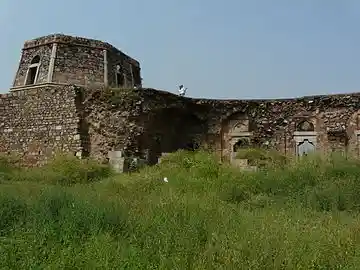JAHANPANAH: THE REFUGEE OF THE TUGHLAQS
The threat of Mughals continued to lurk in the Tughlaq Dynasty. While they tried to defend their empire through various means, building a well-fortified empire checked on the top of their list. Muhammad Bin Tughlaq wanted to address this situation as soon as possible and came up with an idea - to construct a new city that would protect them from the Mughals at all cost.

Bijat Mandal in Jahanpanah. Image Courtesy: Wikimedia Commons
And then came up the fourth city of Delhi- Jahanpanah. It was built between 1326 and 1327. The Adilabad fort along with all the establishments between Qila Rai Pithora and Siri Fort were going to be a part of this new city. It was to have 13 gates. However, the city doesn’t survive today. The city wall of Jahanpanah that dots the present-day Qutub Minar and IIT Delhi landscape is the only remnant of this medieval city.
In an effort to answer the question of its destruction and ruination, various historians have come up with theories. One such approach believes in the reckless decision taken by Mohammad Bin Tughlaq to shift his capital from Delhi to Deccan, only to fail and return.
Ibn Batuta was one of the prominent travellers during the rule of the Tughlaq emperors. In his chronicle, Batuta wrote that Siri was the military cantonment while Lal Kot became an urban region within the city. The Hazar Sultan Palace was believed to be the residence of the Tughlaq. According to Ibn Batuta, Muhammad Shah wanted to see a unified city of all the three cities together as one unified capital. However, the cost was phenomenal and, hence, he dropped the plan midway.
Muhammad Shah had to give up his plan and construct a new city for himself - Firozabad. The new city is going to be the next in line for the numerous capitals in Delhi.
Through various excavation activities conducted to know more about the fourth city of Delhi, different historians believe that the area for the city contained the citadel with sultan’s palace complex, main mosque and an area for the citizens restored in the first city of Delhi- Lal Kot.
It is believed that the Begumpuri Mosque that is currently located in the Begumpur Village was the primary mosque of Jahanpanah and the Bijay Mandal group of buildings near the mosque was probably the royal residence. The late 14th century Lal Gumbad, Serai Shaji Mahal, Baradari, and Kharbuze ka Gumbad are also believed to be associated with the Jahanpanah city.

Ruins of the Palace. Image Courtesy: Wikimedia Commons

Location in Delhi. Image Courtesy: Wikimedia Commons


